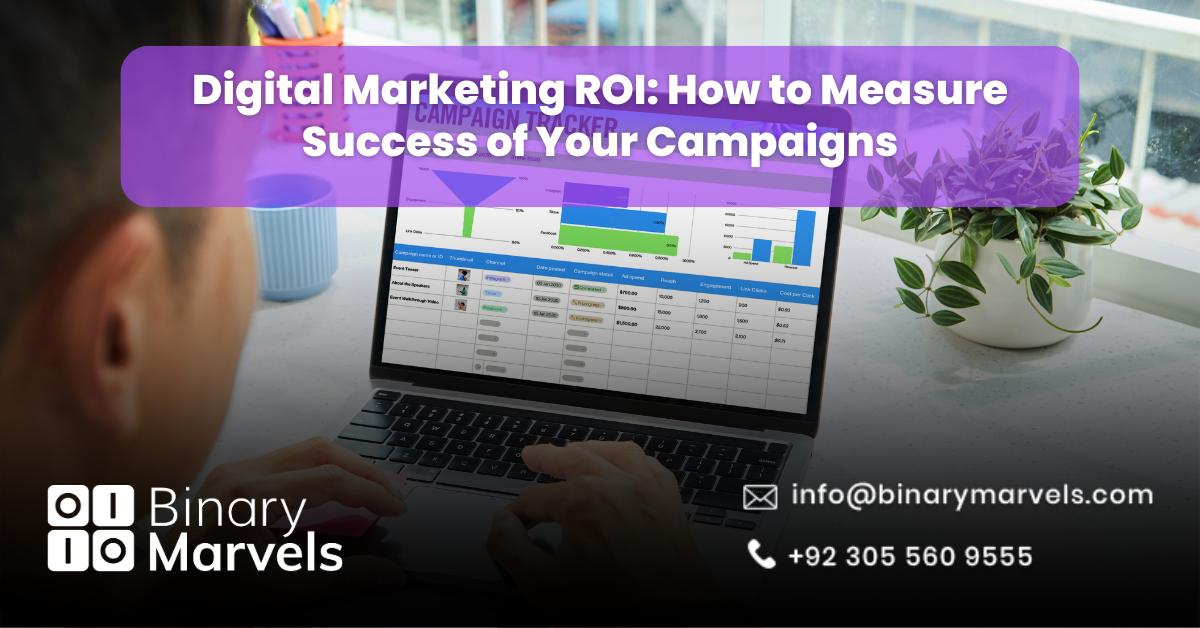
Are you truly getting the most out of your digital marketing campaigns? Many businesses invest heavily in online advertising, content, and social media, but without tracking results properly, it’s impossible to know what’s working and what isn’t. Understanding Digital Marketing ROI: How to Measure Success of Your Campaigns is essential to ensure every pound or dollar you spend drives real value for your business.
By measuring ROI effectively, you can identify high-performing strategies, reduce wasted spend, and make data-driven decisions that grow your revenue and strengthen your brand presence online. Whether you’re running paid ads, email campaigns, or content marketing, knowing how to calculate and interpret ROI turns your efforts into measurable success.
This guide will walk you through the key metrics, tools, and strategies you need to accurately measure and improve your digital marketing ROI.
What is Digital Marketing ROI?
Digital Marketing ROI, or Return on Investment, is a measure of how much value your marketing efforts generate compared to the cost of running them. It helps businesses understand whether their campaigns are profitable and where improvements are needed.
The basic formula to calculate ROI is:
ROI = (Revenue – Investment) ÷ Investment × 100%
For example, if you spend £1,000 on a campaign and it generates £3,000 in revenue, your ROI would be 200%.
ROI is not just about revenue. It also includes other benefits like lead generation, customer engagement, and brand awareness. By tracking these metrics, you gain a complete picture of your campaign’s effectiveness and can make informed decisions to optimize future strategies.
Also Read: 10 Ways Small Businesses Can Improve Their Social Media Presence
Key Metrics to Measure Digital Marketing ROI
To understand the success of your campaigns, it’s important to track the right metrics. Here are the key indicators that give a clear picture of your digital marketing ROI:
Conversion Rate
Conversion rate shows the percentage of visitors who take a desired action, such as making a purchase, signing up for a newsletter, or filling out a contact form. A higher conversion rate indicates that your campaign is effectively turning traffic into results.
Customer Acquisition Cost (CAC)
CAC measures how much it costs to acquire a new customer. By comparing CAC with the revenue generated from each customer, you can determine whether your marketing efforts are cost-effective.
Lifetime Value (LTV)
Lifetime Value represents the total revenue a customer is expected to generate over their relationship with your business. Understanding LTV helps you invest in marketing strategies that attract high-value customers.
Traffic Sources and Engagement Metrics
Analyzing where your traffic comes from helps identify which channels deliver the best ROI. Engagement metrics like bounce rate, time on site, and page views show how interested your audience is in your content.
Revenue and Sales Metrics
Tracking direct revenue from campaigns is essential to measure ROI. This includes online sales, leads converted to sales, and any other measurable financial impact from your marketing activities.
Monitoring these metrics consistently ensures that you can make data-driven decisions to optimize your campaigns and maximize returns.
Tools to Measure Digital Marketing ROI
Measuring ROI accurately requires the right tools to track performance and analyze data. Here are some essential tools that can help you evaluate your digital marketing campaigns:
Google Analytics
Google Analytics provides detailed insights into website traffic, user behavior, and conversions. It helps you understand which campaigns drive the most engagement and revenue.
HubSpot
HubSpot offers marketing automation, lead tracking, and detailed reporting. It’s ideal for measuring the effectiveness of email campaigns, landing pages, and customer journeys.
SEMrush and Ahrefs
These tools help track SEO performance, keyword rankings, and competitor analysis. They are useful for evaluating organic traffic and content marketing ROI.
Facebook Ads Manager and Google Ads
Paid advertising platforms like Facebook Ads Manager and Google Ads allow you to monitor campaign performance in real-time, including clicks, conversions, and cost per acquisition.
Using these tools consistently ensures you can track key performance indicators, identify high-performing strategies, and make data-driven decisions to improve your ROI.
Also Read: 8 Steps to a Digital Marketing Strategy for Small Businesses
Steps to Improve Your Digital Marketing ROI
Improving your digital marketing ROI requires a strategic approach and continuous optimization. Here are the key steps to boost the effectiveness of your campaigns:
Set Clear Goals
Define what success looks like for each campaign. Use SMART goals—specific, measurable, achievable, relevant, and time-bound—to guide your marketing efforts.
Identify Key Performance Indicators (KPIs)
Focus on metrics that directly relate to your objectives, such as conversions, revenue, engagement, or lead generation. KPIs help you measure progress accurately.
Use A/B Testing
Test different versions of ads, landing pages, and emails to see which performs best. A/B testing helps you optimize campaigns for higher conversions and better ROI.
Optimize Campaign Budget
Allocate your marketing budget based on performance data. Invest more in high-performing channels and reduce spending on underperforming ones.
Continuous Monitoring and Reporting
Regularly review campaign performance to identify trends, successes, and areas for improvement. Consistent monitoring allows you to adjust strategies quickly and maximize returns.
Following these steps ensures your marketing efforts are efficient, cost-effective, and aligned with your business goals.
Common Mistakes in Measuring ROI
Measuring digital marketing ROI can be challenging, and businesses often make errors that lead to misleading results. Being aware of these common mistakes can help you avoid them:
Ignoring Qualitative Metrics
Focusing only on revenue can overlook important benefits like brand awareness, customer engagement, and loyalty, which also contribute to long-term ROI.
Overlooking Attribution Models
Not tracking how different channels contribute to conversions can result in misallocated budgets and inaccurate ROI calculations.
Not Considering Multi-Channel Campaigns
Marketing campaigns often span multiple platforms. Failing to measure performance across all channels can give an incomplete view of ROI and prevent informed decision-making.
By avoiding these pitfalls, you can get a more accurate understanding of your campaigns’ true performance and make better strategic decisions.
Supercharge Your Business with Digital Marketing Today!
As a trusted Digital Marketing Agency in Rawalpindi, we deliver result-driven digital marketing services designed to boost your online presence, generate leads, and grow your business.
Don’t wait, connect with us now and take your brand to the next level!
Conclusion
Measuring the ROI of your digital marketing campaigns is essential to understand their effectiveness and make data-driven decisions. By tracking the right metrics, using reliable tools, and continuously optimizing your strategies, you can maximize returns and ensure your marketing budget is well-spent.
Working with a professional digital marketing agency can help you accurately track ROI, improve campaign performance, and achieve better results. With the right approach, every campaign becomes an opportunity to grow your business, increase engagement, and generate measurable success.









